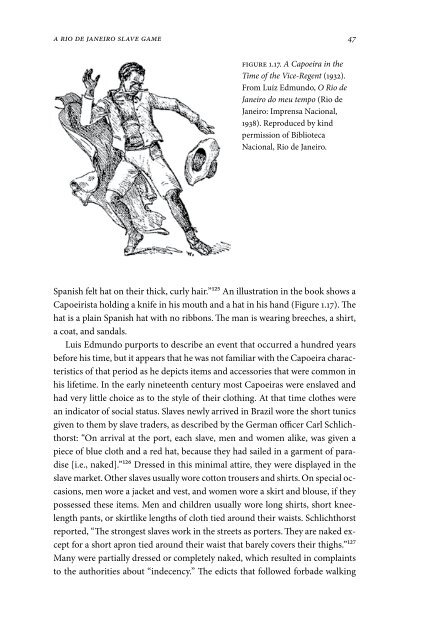A Collision of Cultures in the Brazilian Battle Dance - Capoeira Music
A Collision of Cultures in the Brazilian Battle Dance - Capoeira Music
A Collision of Cultures in the Brazilian Battle Dance - Capoeira Music
Create successful ePaper yourself
Turn your PDF publications into a flip-book with our unique Google optimized e-Paper software.
a rIo de JaneIro Slave Game<br />
FIGuRe 1.17. A <strong>Capoeira</strong> <strong>in</strong> <strong>the</strong><br />
Time <strong>of</strong> <strong>the</strong> Vice-Regent (1932).<br />
from Luíz edmundo, O Rio de<br />
Janeiro do meu tempo (rio de<br />
Janeiro: imprensa nacional,<br />
1938). reproduced by k<strong>in</strong>d<br />
permission <strong>of</strong> Biblioteca<br />
nacional, rio de Janeiro.<br />
spanish felt hat on <strong>the</strong>ir thick, curly hair.”125 an illustration <strong>in</strong> <strong>the</strong> book shows a<br />
Capoeirista hold<strong>in</strong>g a knife <strong>in</strong> his mouth and a hat <strong>in</strong> his hand (figure 1.17). The<br />
hat is a pla<strong>in</strong> spanish hat with no ribbons. The man is wear<strong>in</strong>g breeches, a shirt,<br />
a coat, and sandals.<br />
Luis edmundo purports to describe an event that occurred a hundred years<br />
before his time, but it appears that he was not familiar with <strong>the</strong> <strong>Capoeira</strong> characteristics<br />
<strong>of</strong> that period as he depicts items and accessories that were common <strong>in</strong><br />
his lifetime. <strong>in</strong> <strong>the</strong> early n<strong>in</strong>eteenth century most <strong>Capoeira</strong>s were enslaved and<br />
had very little choice as to <strong>the</strong> style <strong>of</strong> <strong>the</strong>ir cloth<strong>in</strong>g. at that time clo<strong>the</strong>s were<br />
an <strong>in</strong>dicator <strong>of</strong> social status. slaves newly arrived <strong>in</strong> Brazil wore <strong>the</strong> short tunics<br />
given to <strong>the</strong>m by slave traders, as described by <strong>the</strong> German <strong>of</strong>ficer Carl schlichthorst:<br />
“on arrival at <strong>the</strong> port, each slave, men and women alike, was given a<br />
piece <strong>of</strong> blue cloth and a red hat, because <strong>the</strong>y had sailed <strong>in</strong> a garment <strong>of</strong> paradise<br />
[i.e., naked].”126 dressed <strong>in</strong> this m<strong>in</strong>imal attire, <strong>the</strong>y were displayed <strong>in</strong> <strong>the</strong><br />
slave market. o<strong>the</strong>r slaves usually wore cotton trousers and shirts. on special occasions,<br />
men wore a jacket and vest, and women wore a skirt and blouse, if <strong>the</strong>y<br />
possessed <strong>the</strong>se items. Men and children usually wore long shirts, short kneelength<br />
pants, or skirtlike lengths <strong>of</strong> cloth tied around <strong>the</strong>ir waists. schlichthorst<br />
reported, “The strongest slaves work <strong>in</strong> <strong>the</strong> streets as porters. They are naked except<br />
for a short apron tied around <strong>the</strong>ir waist that barely covers <strong>the</strong>ir thighs.”127<br />
Many were partially dressed or completely naked, which resulted <strong>in</strong> compla<strong>in</strong>ts<br />
to <strong>the</strong> authorities about “<strong>in</strong>decency.” The edicts that followed forbade walk<strong>in</strong>g






